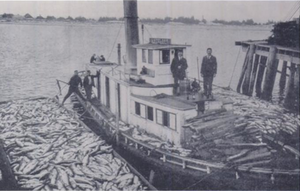
The history of steamboats on the Oregon Coast begins in the late 19th century. Before the development of modern road and rail networks, transportation on the coast of Oregon was largely water-borne. This article focuses on inland steamboats and similar craft operating in, from south to north on the coast: Rogue River, Coquille River, Coos Bay, Umpqua River, Siuslaw Bay, Yaquina Bay, Siletz River, and Tillamook Bay. The boats were all very small, nothing like the big sternwheelers and propeller boats that ran on the Columbia River or Puget Sound. There were many of them, however, and they came to be known as the "mosquito fleet."

The Coquille River starts in the Siskiyou National Forest and flows hundreds of miles through the Coquille Valley on its way to the Pacific Ocean. Bandon, Oregon, sits at the mouth of the Coquille River on the Pacific Ocean. Before the era of railroads and later, automobiles, the steamboats on the Coquille River were the major mode of transportation from Bandon to Coquille and Myrtle Point in southern Coos County, Oregon, United States.

The Coos Bay Mosquito Fleet comprised numerous small steamboats and motor vessels which operated in the late 19th and early 20th centuries on Coos Bay, a large and mostly shallow harbor on the southwest coast of the U.S. state of Oregon, to the north of the Coquille River valley. Coos Bay is the major harbor on the west coast of the United States between San Francisco and the mouth of the Columbia River.

T.M. Richardson was a steamboat built in 1888 at Oneatta, Oregon, which served on Yaquina Bay and on the Yaquina River from 1888 to 1908. This vessel was commonly known as the Richardson or the T.M.

Rainbow was a sternwheel steamboat that was operated in the Coos Bay region of Oregon from 1912 to 1923. Rainbow is sometimes referred to as a "launch", meaning a small steamboat. This vessel's name is sometimes seen as Rain-Bow.
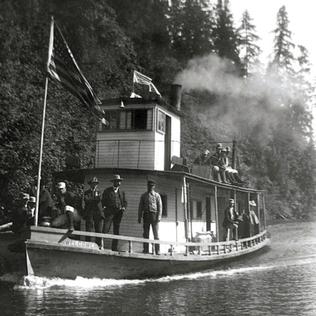
Welcome was a sternwheel steamboat that was operated on the Coquille River on the south Oregon coast from 1900 to 1907.

Dora was a sternwheel steamboat that was operated on the Coquille River on the southern coast of Oregon from 1912 to 1923. This vessel should not be confused with a number of other craft of the same name operating at the same time in other parts of North America.

Coquille was a steamboat built in 1908 for service on the Coquille River and its tributaries. Coquille served as a passenger vessel from 1908 to 1916, when the boat was transferred to the lower Columbia River. Coquille was reconstructed into a log boom towing boat, and served in this capacity from 1916 to 1935 or later.

Echo was a sternwheel steamboat that was operated on the Coquille River on the Southern Oregon Coast from 1901 to 1910.

Liberty was a sternwheel steamboat that was operated on the Coquille River and then on Coos Bay from 1903 to 1918. Liberty was notable for having its ownership entangled in various legal claims in the early 1910s, including some involving a colorful North Bend, Oregon business promoter Lorenzo Dow "Major" Kinney (1855-1920).

Dispatch was a sternwheel steamboat that was operated on the Coquille River on the southern Oregon coast from 1903 to 1920. The name of this vessel is sometimes seen spelled Despatch. This sternwheeler should not be confused with an earlier and somewhat smaller sternwheeler, also named Dispatch, that was built at Bandon, Oregon, in 1890, for which the 1903 Dispatch was a replacement.

Telegraph was a sternwheel steamboat that was operated on the Coquille River on the southern Oregon coast from 1914 to 1927. Telegraph is perhaps best known for having been in involved in collisions with rival steamboats, apparently as a result of fierce competition for business on the Coquille River.

Eva was a sternwheel steamboat that was operated on the Umpqua River on the Oregon coast in the early part of the 1900s. Eva was notable for long service on a short route of about 20 miles. Eva was also notable for having been used by one of its owners to illegally transport dynamite on a passenger-carrying vessel, by the ruse of labeling the dynamite boxes as "bacon."
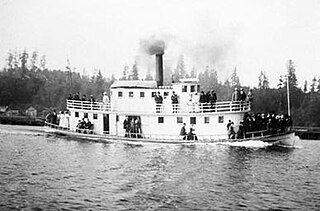
Favorite was a small steamboat that was operated on the Coquille River, Coos Bay and on the Siuslaw River, in the southern Oregon coast region from 1900 to 1918.

Wolverine was a launch powered by a gasoline engine that operated on the Coquille River on the southern coast of Oregon, United States, from 1908 to the 1920s. Later the boat operated on Coos Bay, and, in the mid-1930s, was transferred to Eureka, California. Wolverine is principally known for its early service as a high-speed passenger vessel.

Little Annie was a sternwheel-driven steamboat that operated on the Coquille River on the Southern Oregon Coast from 1876 to 1890. This steamer should not be confused with a number of other vessels with the same name operating at about the same time in various parts of the United States.
W.H. Harrison was a steam schooner that operated from 1890 to 1905 on the coast of Oregon, the lower Columbia River, and southwest Washington state. At that time the salmon cannery industry was one of the major businesses of the coast. W.H. Harrison, while also carrying passengers and transporting general freight and lumber, was one of a number of steamers supplying materials to canneries along the coast, and transporting cases of canned salmon from the canneries.
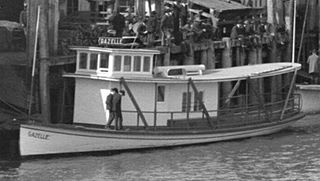
Gazelle was a gasoline powered launch that operated on the Willamette and Columbia river from 1905 to 1911. For short periods of time Gazelle was operated on the Oregon Coast, on Yaquina Bay and also as an off-shore fishing vessel, in the Coos Bay area.
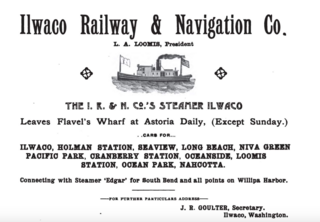
Ilwaco was a small riverine and coastal steamship built in 1890 which was operated as a passenger vessel for the Ilwaco Railway and Navigation Company, and later served in other roles, including tow and freight boat, cannery tender and fish packing vessel. Ilwaco was originally named Suomi.

The Callendar Navigation Company, sometimes seen as the Callendar Transportation Company, started in business in the early 1900s. Callendar was formed in the early 1900s, and was based in Astoria, Oregon. Callender was to become one of six large towing companies of the Columbia and Willamette rivers in the early decades of the 1900s, the others being Shaver Transportation, Smith Transportation, Hosford, Knappton Towing Co., and Willamette and Columbia River Towing Co. In 1922, Callendar Navigation merged with Knappton Towboat Co., which existed, with a name change in 1990, and which became part of Foss Marine in 1993.
